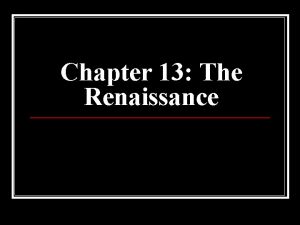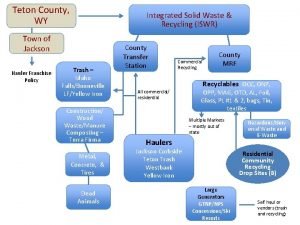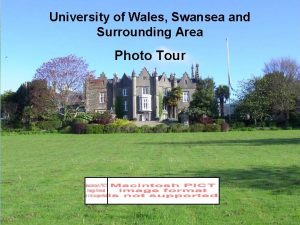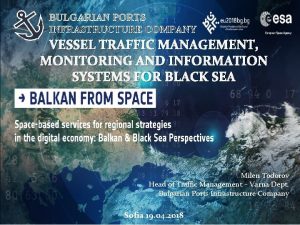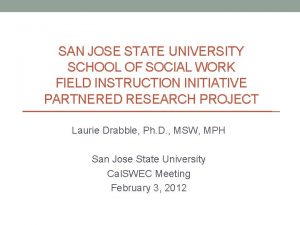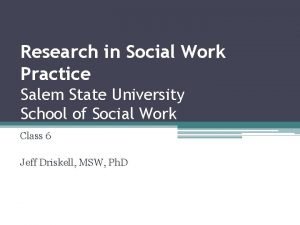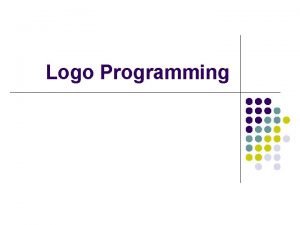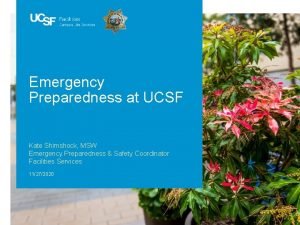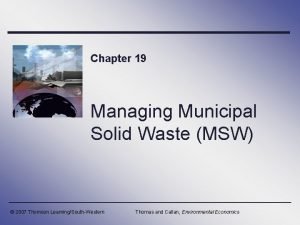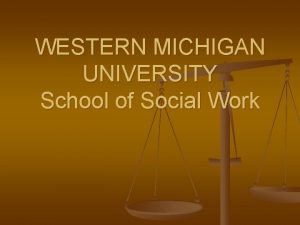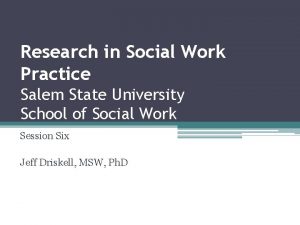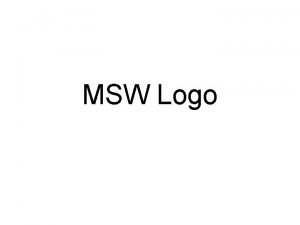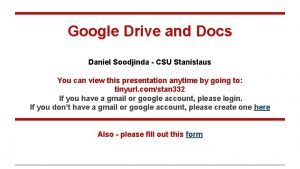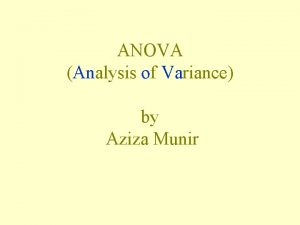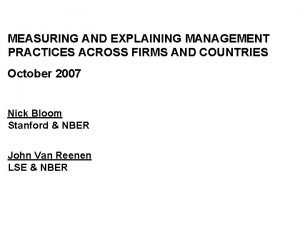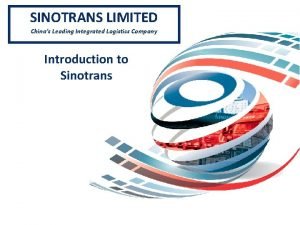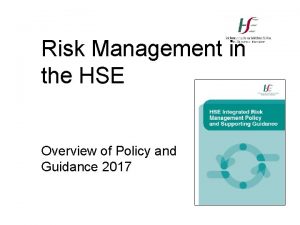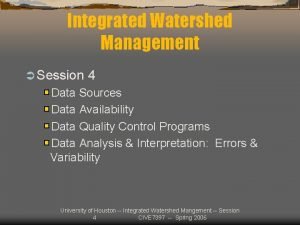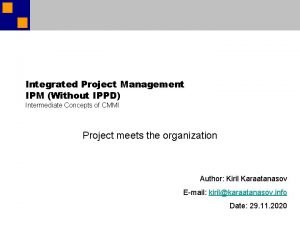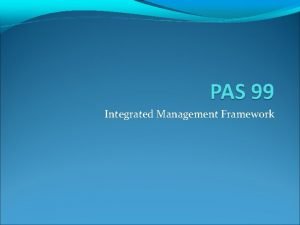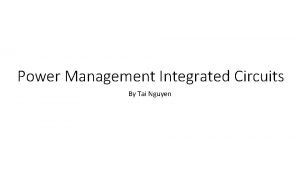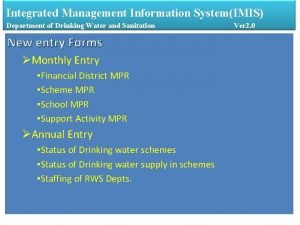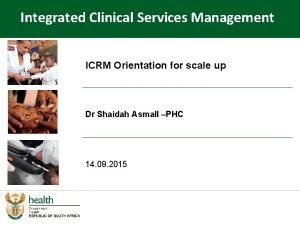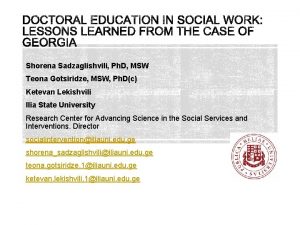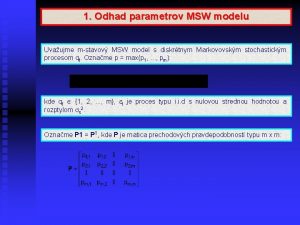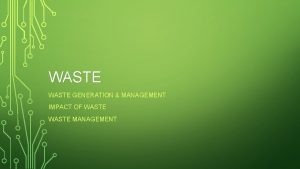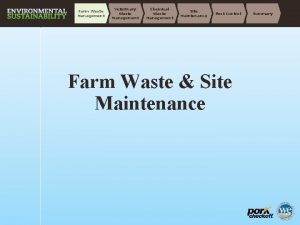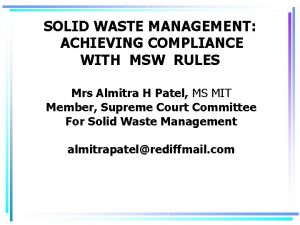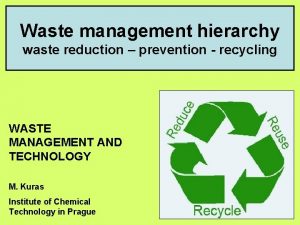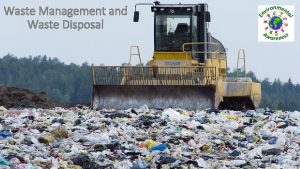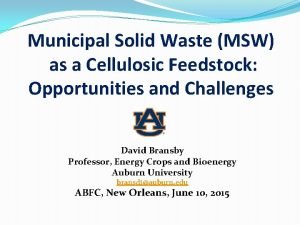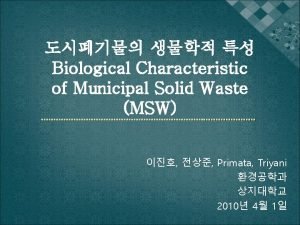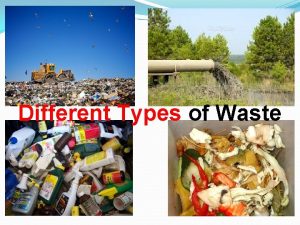Integrated waste management of MSW across Europe Waste
















































- Slides: 48

Integrated waste management of MSW across Europe Waste to Energy as a professional route to treat residual waste. Jan Manders Deputy President CEWEP Energy from Waste Consult Kosice, 18 th October 2012 1

Topics for this session • How did Waste Management develop in Europe • EU Directives and legislation • Best Practice in Europe for integrated waste management and alternative approaches • Waste to Energy: current practice and outlook • Emission and health aspects • Renewable Energy and Climate Change aspects • Communication to stakeholders 2

CEWEP Confederation of European Waste-to-Energy Plants CEWEP represents 371 of 452 Waste-to-Energy plants across Europe. (62 mt of EU capacity of 73 mt in 2010) They thermally treat household and comparable waste, which is not otherwise reused or recycled, and generate energy from it. In 2010 across Europe they supplied: 30 TWh electricity (6 m hholds) 72 TWh of heat. (5 m hholds) 3

Waste Management across Europe divided into 3 groups • Leading countries DE, NL, SE, BE, AT, CH, DK • Sophisticated legislation and enforcement • Extensive SS collection and treatment infrastructure • No Landfill of MSW anymore • Group making steady progress but long way to go e. g. FR, UK, IT, ES, PT, FI, NO, IE • Landfill diversion slow, less Wt. E • Compromises, political complications, NGO’s • Countries which are way behind : new entrants, GR 4

How did leading countries in Europe develop in the past? Initiatives go back to the 1970’s in DE, NL, CH, Nordic • Growing awareness on environment, concern on soil pollution, scandals, land scarcity • Set up source separation, recycling and incineration • Instruments to discourage landfill: taxation, bans • Comprehensive legislation and waste hierarchy (NL) • Visionary energy strategy and important role for Wt. E plants (SE and DK) • Eventually have become model for overall EU approach 5

Current EU Framework on Legislation : Set of EU Directives to be implemented into national legislation. Relevant examples: • Landfill Directive : binding landfill diversion targets • Waste Framework Directive • Waste hierarchy, Energy Recovery status • End of Waste criteria • Recycling targets for MSW • Waste Incineration Directive (-> IED) : emission limits • Renewable Energy Directive: binding targets for utilisation of Renewable Energy by 2020 • ETS directive (CO 2 Emission Trading) 6

EU Landfill Directive According to the Landfill Directive (1999/31/EC) biodegradable municipal waste going to landfills must be reduced (base year 1995): to 50 % by 2009 and to 35% of the total amount by 2016. Poor landfills are a threat to the environment: -- Contamination of water and soil -- Methane emissions (GHG) -- Loss of materials Derogations: For countries that had 80% landfilling in 1995: 50% Until 2013 Greece, Poland United Kingdom New Member states: 2014 Bulgaria 2017 Romania

Diversion of biodegradable waste from landfills the EU targets and country status in 2006 source: Eur Commission

Waste Hierarchy adopted by EU within the Waste Framework Directive The 5 step waste hierarchy Prevention in the Waste Framework Directive helps to achieve Reuse sustainable waste management, Recycling placing prevention at the top and disposal (such as Other recovery landfilling) as the least favoured option. e. g. energy recovery Disposal 9

Amount of MSW per capita in EU countries (total amount of waste leaving the household) Waste composition varies across Europe 10

Treatment of MSW in Europe EU 27, 260 m tpa in 2009 Recycled 24% "Bio Recycled" 18% Landfilled 38% Thermal Tr 20 % Treatment of Municipal Solid Waste in the EU 27 in 2009 Source: EUROSTAT A large part of the EU 27 waste is still wasted by putting it on landfills with negative effects on the environment. But waste is a precious resource which should be utilised! 11

Treatment of MSW across Europe in 2009 Source: EUROSTAT Recycling Graph created by CEWEP „Bio-Recyling“ Thermal Treatment Landfilling 12

Screening report by BIPRO for EU Com July 2012: implementations gaps across MS? • Which are implementations gaps with individual member states on key elements of EU directives, notably Landfill Directive and Waste Framework Directive • Core elements are: implementation of WFD, financial and legal instruments, infrastructure, planning, target setting and applying infringement procedures. • Semi quantitative analysis after desk exercise of performance of all 27 member states 13

Summary of major findings of screening report by BIPRO (max 42 points to be received) green max score; red min score 14

Summary of results BIPRO report: EU divided into 3 groups based on performance • First group 10 MS: 39 – 31 points in descending order AT, NL, DK, DE, SE, BE, LU, GB, FI, FR • Second group 5 average MS (25 to 19 points) SL, ES, PT, HU, IE • Third group: 12 MS scoring 18 down to 3 IE, CZ, PL, EE, SK (17), IT, LV, CY, RO, LT, MT, BG, GR(3) 15

Successful Strategy for Integrated Waste management in various West- European countries Separation at source Organic textiles glass paper packaging Residual Waste Bulky Dom. Waste AD +Compost. Compost r e c y c l i n g Domestic and Comparable Waste Wt. E Energy Bottom ashes R Residue material* Metals R Separation Wood Biomass Energy Plants Rubble R RDF pellets cement kilns etc. R landfill * backup 16

Promoting recycling by targets set in the Waste Framework Directive • Targets in Art 11(2) WFD to be achieved by 2020 • preparation for re-use and recycling of materials “such as at least” paper, metal, plastic, glass from households + option for similar wastes to be increased to “a minimum of overall” 50% • preparation for re-use, recycling and backfilling of 70% construction & demolition waste • Various options for assessing the performance

Alternative processing routes : variants of MBT , especially for situations with little / no source separation Paper, metals, plastics, etc M S W Separation & Sorting combustible Fuel preparation Biological Drying RDF SRF Recycling Incineration Heat / Electricity Landfill Residue Organics Anaerobic Digestion Composting Biogas Energy Compost ? Meeting specs ? If not landfill

Why were/are sorting & MBT variants for Residual Waste being considered ? (DE, AT, IT, ES, UK ) • Hope to avoid the investment of incineration plants. • Hope that RDF/ SRF would become « end of waste » general purpose fuel finding many applications The Reality is however: • MBT is only a pre-treatment • RDF is and will be waste, continuing to fall within EU waste emission legislation (WID, IED) • RDF fuel is finding application in cement kilns; potential for co-incineration in power plants is very limited • Majority of RDF is finding its way into dedicated incineration plants ( = Wt. E plant for residual MSW) 19

Landfill bans in Europe 10 countries: AT (requires pre-treatment; TOC must not exceed 5%) BE (unsorted waste) CH (combustible waste) DE (requires pre-treatment) DK (combustible waste) EE (unsorted MSW) Fl (household waste without sorting biodegr. mun. waste) NL (combustible waste) NO (> 10% TOC) SE (combustible & organic waste) 20

Landfill taxes in Europe 18 countries: AT, BE, CH, CZ, DK, EE, ES, Fl, FR, IE, IT, LT, NL, NO, PL, SE, Sl, SK, UK Range: 3. 5 €/t in Portugal – 107 €/t for combustible waste in NL More details about landfill bans and taxes: http: //www. cewep. eu/information/data/landfill/index. html 21

Typical composition of RESIDUAL MSW Component % NL 2008 France 2007 Organic 31 31 Paper & cardboard 22 16 Plastics 19 12 Diapers 6 10 Glass 5 6 Metals 3 3 Textiles 4 3 Others 10 19 Total 100 22

Waste to Energy in Europe (Incineration with Energy Recovery of MSW and comparable waste) § dominant route for the treatment of residual waste (and of RDF or sorting residues) § Fully proven and environmentally safe thanks to FGC § About 71 million tonnes of capacity in operation in 2009 supplying about 30 TWh of electricity (6 million hh) and about 55 TWh of heat (5 million hh) § about 50 % of this energy is classified as renewable § represents a net CO 2 saving and avoids the use of fossil fuels elsewhere for energy production

Feedstock for Wt. E plants in Europe • Mostly a combination of Residual MSW and Commercial Waste (collected by private business) e. g. in NL ratio 70: 30 calorific value in range 9 – 10 MJ/ kg • Some new plants are designed for dedicated incineration of RDF or sorting fractions (DE and UK) Calorific value up to 14 MJ/kg • 24

Wt. E producing local energy making Europe less dependant on fossil fuels imports Energy content of waste 1 tonne brown coal 1 tonne Municipal Waste or = 0. 330 tonnes hard coal ca. or 250 litres oil Assuming that the calorific value of municipal waste = 10 MJ/kg, brown coal = 9 MJ/kg, hard coal = 30 MJ/kg, oil = 42 MJ/kg

Typical Waste-to-Energy Plant Incineration/ Energy recovery Flue-gas cleaning Waste delivery 1. Tipping hall 8. DENOx catalyst 15. Primary air fan 2. Waste bunker 9. Economiser 16. Re-circulation fan 3. Grabs 10. Spray drier 17. Re-circulation to ECO 4. Feed chute 11. Fabric filter 18. Turbine and generator 5. Moving grate 12. Fan 19. Boiler water tank 6. Boiler 13. Stack 20. Residue silo 7. Electrostatic precipitator 14. Bunker air extraction 21. Bottom ash bunker 26

72 million tonnes of remaining waste in Europe 29 billion k. Wh electricity supplying 13 million inhabitants 72 billion k. Wh heat Metals from bottom ash 7 – 40 million tonnes of fossil fuels Year 2010

Application of Power and Heat in Europe • Production of Electricity is obligatory; Older plants have modest electrical efficiency; Newer plants designed for optimum electrical efficiency (steam conditions, turbine type) • Supply of electricity to the grid, or local customer • Supply of high pressure steam to industrial customer nearby e. g. paper company, chemicals plant, water desalination • Supply of hot water/ low pressure steam to district heating system e. g. in Nordic, NL DE, CR • Maximum Energy Efficiency can be achieved by combination of supply of Power and Heat 28

Bottom Ash from Waste to Energy Plants • Extensive application of bottom ash in civil works in e. g. NL, DE, BE, FR, DK, IT • Active development of other applications in building materials: bricks, concrete • Major process optimisation in recovery of more nonferrous material from bottom ash : Al and Cu • Some countries do not permit application of bottom ash other than as cover for landfill. e. g. CH • Development of dry extraction route (CH): dry bottom ash with high levels of recovery of Al and Cu 29

EU Waste Incineration Directive: Emission Limit Values (ELV) for Wt. E incineration Component Limit value Period (Cd) and (Tl) 0, 05 mg/m³ max 8 hours • 0, 05 mg/m³ max 8 hours (Sb), (As), (Pb), (Cr), (Co), (Cu), (Mn), (Ni), (V) 0, 5 mg/m³ max 8 hours dioxins and furans, 0, 1 ng/m³ max 8 hours (CO) 50 mg/m³ daily average value dust 10 mg/m³ daily average value (HCl), 10 mg/m³ daily average value (HF), 1 mg/m³ daily average value (SO 2), 50 mg/m³ daily average value (No), (NO 2) (depending on plant size). 200 mg/m³ - 400 mg/m³ daily average value (Hg) 30

Waste-to-Energy Dioxin emissions have been minimised ! In 1990 400 g Dioxin emissions dropped to approx. 1/1000 In 2000 0, 5 g “in 1990 one third of all dioxin emissions in Germany came from waste incineration plants; during the year 2000 the figure was less than 1% ” Source: German Federal Environment Ministry (BMU), July 2005. 31

Health studies The Scientific Advisory Council of the Federal Medical Association (Germany) investigated potential health risks caused by emissions of Waste-to-Energy Plants, concluding: “The evaluation conducted shows that currently operating Waste-to-Energy Plants, which conform to the technical standards, cause very marginal health risks, which can therefore be classified as negligible health risks for the population living in the vicinity of Waste-to-Energy Plants” Source: German Medical Journal 90, edition 1 / 2, 11 th of January 1993, p. 45 -53, Publications 32

Waste-to-Energy in Europe in 2010 Finland 3 0. 3 Norway 17 1. 2 • Waste-to-Energy Plants operating in Europe (not including hazardous waste incineration plants) • Waste thermally treated in Waste-to-Energy plants in million tonnes Sweden 32 5. 1 Estonia Latvia Denmark 29 3. 5 Ireland Lithuania United Kingdom 24 4. 2 Data supplied by CEWEP members unless specified otherwise * From Eurostat ** Includes plant in Andorra Portugal 3 1. 1 Spain** 11 2. 0 Poland* Netherlands 1 0. 04 11 6. 5 Germany 70 20. 0 Belgium Czech Republic 16 3. 0 Luxembourg* 3 0. 5 Slovakia* 1 0. 1 2 0. 2 Austria France 13 2. 1 Hungary 129 13. 7 Switzerland Romania 1 0. 4 30 3. 7 Slovenia* 1 0. 01 Bulgaria Italy 53 5. 7 Greece info@cewep. eu www. cewep. eu

Incinerated MSW in EU 27+CH+NO 2001 -2010, in tonnes 450 447 430 425 415 357 414 403 390 343 390 325 328 187 328 361 369

Number of Wt. E plants in EU 27+CH+NO, 2001 -2010

Wt. E Capacity Europe by end of 2008 is 71 m tonnes. Arial

Average size of Wt. E plants varies from country to country

Wt. E capacity growth in steps (includes MSW & comparable & dedicated RDF/SRF incin plants)

Waste to Energy Capacity Development within Europe Country Groups Likely developments Potential for expansion DE, NL, DK, SE, CH, A, BE Recent extensions Demand Capacity in balance or slight overcapacity emerging FR, IT, ES, PT, IE Market opportunities, but complications due to local policies & preferences UK, CZ, PL, Major extension potential GR, new EU entrants Major potential, but various complications and hurdles despite EU support

Climate Change Aspects • CO 2 accounting systems available • Consensus on CO 2 impact from Waste to Energy, although some NGO disagreement • Emission Trading Scheme ETS; until 2013 Wt. E is not in, we are lobbying to stay out • Renewable Energy major topic in EU; Contribution from Waste, Wt. E is being recognized 40

Net CO 2 emissions from modern Wt. E plants A state-of- the art Wt. E plant saves CO 2 in the range of 100 to 350 kg CO 2 eq per tonne of waste processed *, depending on: • Waste composition (% biogenic) • Amount of heat and electricity supplied • Country Energy substitution mix If Wt. E replaces (poor) landfilling, then there would be additional savings of 200 to 800 kg CO 2 /tonne waste * The more energy can be supplied as heat the higher the CO 2 savings

Energy from Waste as a source of Renewable Energy • EU binding targets on RE : 20 % by 2020, differentiated by country • Major gap of 1500 TWh of RE to be filled by solar, wind, hydroelectric, biomass, waste • Renewable Energy from waste is « low hanging fruit » : easy-to-achieve, reliable and relatively cheap • CEWEP study shows that Ef. W might contribute 95 TWh, of which the largest contribution is through Wt. E, followed at a distance by SRF/RDF and LFG 42

Communication with stakeholders on Waste-to-Energy Communication with stakeholders is often the most important issue when considering investment in Wt. E: • Who are our stakeholders ? • Local community, neighbours • Politicians • Media • NGO’s and pressure groups • Authorities 43

Communication with stakeholders on Waste to Energy Communication is generally effective when: • Taking stakeholders seriously: attitude • Being honest, transparent and consistent • Not reactive but proactive • Making use of various media and instruments: leaflets, newspaper, website, guided tours… • Third Party Advocates have a role to play 44

Thank you for your attention ! CEWEP Confederation of European Waste-to-Energy Plants Office in Brussels: Boulevard Clovis 12 A B-1000 Brussels BELGIUM Tel. : +32 (0)2 770 63 11 Fax: +32 (0)2 770 68 14 e-mail: info@cewep. eu www. cewep. eu Jan. manders@efwc. nl 45

EU 27 have ambitious targets for Renewable Energy overall 20 % of consumption by 2020 50 Binding targets 2020 and actual 2005 Renewable Energy as % of total consumption EU 27 45 40 35 30 25 2020 Target 2005 Level 20 15 10 5 0 SE LV FI AT PT EE RO DK SL LT FR BG ES PL GR SK CZ DE IT HU IE CY NL BE GB LU MT EU 27 The gap to close is about 1500 TWh of Renewable Energy (at a flat – zero growth - EU energy consumption level of 13700 TWh) 46

Agreed formulae within the WFD for the R 1 Efficiency criterion Treatment of waste in a Wt. E plant is recovery if: An existing plant meets efficiency factor > 0, 6 New plant (from 2009) meets efficiency factor > 0, 65 Energy efficiency formulae: Energy produced – (Energy in added fuel + Energy import) 0, 97* x (Energy in the waste + Energy in added fuel) Equivalency factor electricity production x 2, 6 Equivalency factor heat exported x 1, 1 * factor accounting for energy losses due to bottom ash and radiation 47

Heat vs Power production by Wt. E plants across EU relative to EU R 1 Criterion Maxim is supply ation of he at Mix of Less efficient plants 48 hea t an R 1=0, 8 0, 6 d p owe r Power only Based on data from majority of CEWEP Wt. E plants
 Lesson 1 the italian renaissance
Lesson 1 the italian renaissance Bonneville transfer station
Bonneville transfer station Msw rhossili
Msw rhossili Transcultural perspective sjsu
Transcultural perspective sjsu Msw vtmis
Msw vtmis Msw apes
Msw apes San jose state school of social work
San jose state school of social work Salem state msw
Salem state msw Msw logo projects
Msw logo projects Aurora university msw
Aurora university msw Sjsu msw advanced standing
Sjsu msw advanced standing Uwf msw
Uwf msw University of texas at arlington school of social work
University of texas at arlington school of social work Msw scholarships 2019
Msw scholarships 2019 Msw 21 sevilla
Msw 21 sevilla Msw online gaming
Msw online gaming Ucsf msw
Ucsf msw A flat fee pricing system for msw services
A flat fee pricing system for msw services Edall button in msw logo
Edall button in msw logo Msw tourniquet
Msw tourniquet Western michigan university school of social work
Western michigan university school of social work Csu stanislaus msw program
Csu stanislaus msw program Msw el callado
Msw el callado Csumb msw
Csumb msw University of memphis school of social work
University of memphis school of social work Msw
Msw Salem state university school of social work
Salem state university school of social work Logo programiranje
Logo programiranje Crtanje pravokutnog trokuta
Crtanje pravokutnog trokuta Aka.msw
Aka.msw Google
Google Aurora university msw
Aurora university msw F=msb/msw
F=msb/msw Management practices across firms and countries
Management practices across firms and countries Performance cycle uncertainty
Performance cycle uncertainty Sinotrans colombia
Sinotrans colombia Risk management framework hse
Risk management framework hse Integrated watershed management
Integrated watershed management Faculty management system project report
Faculty management system project report Integrated talent management scorecards
Integrated talent management scorecards Integrated service management
Integrated service management Cmmi ipm
Cmmi ipm Pas 99 adalah
Pas 99 adalah Enterprise wide quality integrated management software
Enterprise wide quality integrated management software Objectives of pest management
Objectives of pest management Integrated educational information management system
Integrated educational information management system Power management integrated circuits
Power management integrated circuits Integrated management information system imis
Integrated management information system imis Integrated clinical services management
Integrated clinical services management
